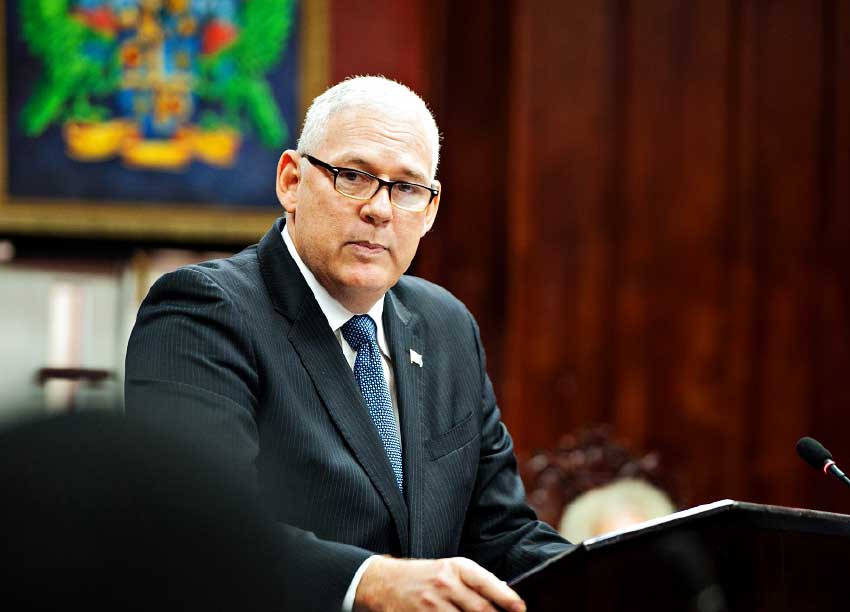PRIME Minister Allen Chastanet this week updated Saint Lucians, via a press conference, on discussions he and his team held this month with the International Monetary Fund (IMF) and World Bank (WB) on issues impacting Saint Lucia as a result of COVID-19.
His explanation, given via a statement, which could be read in its entirety at www.thevoiceslu.com, revealed that for fiscal year 2020, tax revenues fell by more than 50% with Saint Lucia’s debt redemption rate in the region of 25% this fiscal year.

“Lower revenues, increased expenditures and significant debt redemptions have significantly affected our cash flows. A large component of the deterioration in fiscal sustainability for St. Lucia reflects increased borrowings to bridge revenue shortfalls and does not reflect fiscal slippage in the traditional sense.
“Despite the effects of the pandemic, the Saint Lucia Government has embarked upon a multiplicity of policy responses to help mitigate the effects of the crisis, and to bring relief to the most vulnerable groups,” Chastanet said.
Highlighted are some of the issues and specific concerns, according to Chastanet, the Saint Lucian delegation at the IMF/WB raised at the IMF/WB meetings, including some recommendations advanced, not just on behalf of Saint Lucia, but also on behalf of Small Island Developing States in the region.
Impact of COVID-19 & Saint Lucia’s Response
The COVID-19 pandemic has had a debilitating impact on many economies across the world. The pandemic has resulted in a marked decline in global travel and curtailed hotel, restaurant and related tourism activities. Many countries, particularly Small Island Developing States, are trying to respond to the pandemic with large segments of their economy closed down, resulting in reduced revenues. This turn of events has in the immediate term led to the need to borrow, in order to bridge the revenue shortfall and build capacity in the health sector, to respond to COVID-19 related illness and to mitigate the spread of the Coronavirus.
Prior to COVID-19, Saint Lucia had made significant progress with its economic growth indicators and had attained a Debt to GDP ratio of 60% as at the end of March 2020. The Government has had to borrow funds from development partners to help mitigate the economic crisis facing the country, particularly because the revenue of the Central Government has been significantly eroded, coupled with additional expenditures related to managing and augmenting the Healthcare system.
As part of the COVID-19 response, the Government of St. Lucia had to increase expenditures on healthcare related measures, such as the establishment of quarantine and isolation centers, the rehabilitation of the Victoria Hospital, the move to OKEU Hospital, the increase in testing capacity, the acquisition of medical equipment and supplies, hiring additional healthcare workers and maintaining health protocols.
The country has also suffered massive unemployment, due to the closure of the tourism sector, all necessitating social and economic relief measures aimed at providing support to the poor and vulnerable, and those directly impacted as a result of the crisis.
Growth in the Caribbean region and St Lucia has been relatively tepid, and traditionally has relied on construction activity and tourism related developments. Prior to COVID-19, Saint Lucia recorded real growth of 1.7 % in 2019, with expectations of 3.0 to 4.0 % for 2020.
Saint Lucia also experienced a decline in unemployment during the period 2017 to 2019, which was driven by developments in the tourism and construction industry. While the decline observed in Saint Lucia’s unemployment was welcomed, estimates suggest that unemployment, as at early June 2020 went back up to 21.0%, primarily due to the effects of COVID-19.
The debt to GDP ratio has spiked on account of projections of a decline in GDP (that could be as high as 20%) for fiscal year 2020. Prior to COVID-19, growth in Saint Lucia’s debt to GDP ratio was flat, with the ratio fluctuating between 61.0 (2016) and 59.6% (2019). Given the initial estimates of the debt to GDP ratio, Saint Lucia was on a path to achieve the 60.0% target by 2030.
For fiscal year 2020, tax revenues have fallen by more than 50%. Our debt redemption rate has been in the region of 25% this fiscal year. Lower revenues, increased expenditures and significant debt redemptions have significantly affected our cash flows. A large component of the deterioration in fiscal sustainability for St. Lucia reflects increased borrowings to bridge revenue shortfalls and does not reflect fiscal slippage in the traditional sense.
Despite the effects of the pandemic, the Saint Lucia Government has embarked upon a multiplicity of policy responses to help mitigate the effects of the crisis, and to bring relief to the most vulnerable groups.
Firstly, there was the development of the COVID-19 Health Response Plan. This plan was initially developed in March 2020 but has since been updated to treat with the new emerging threats of the further spread of the virus.
Secondly, there was the development of the Social Stabilization Programme, which was announced on 8th April 2020. This program allowed for the provision of income support, tax relief, and other social support measures which catered to individuals, households and businesses most impacted by the pandemic.
Thirdly, there was the development of the Economic Recovery & Resilience Plan (ERRP), which was launched on 12th July 2020. This plan encompasses a broad array of strategies to mitigate the impact of COVID-19. The ERRP was established on 6 pillars (3 Recovery pillars and 3 Resilience pillars). These pillars are further broken down into 32 interventions, all aimed at sustaining and stimulating the economy, whilst bringing about some level of recovery. Quite a number of these interventions have been rolled and the remaining ones will be rolled out in the coming months. It must be noted that this plan is very extensive, and covers a rollout period of 12 months.













